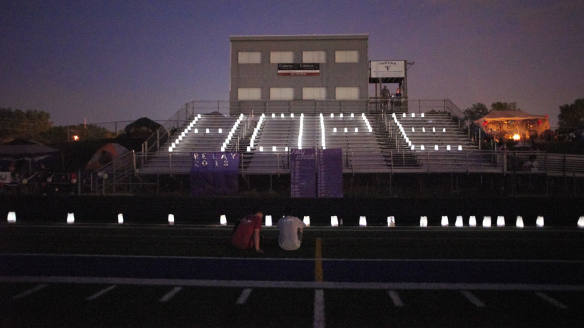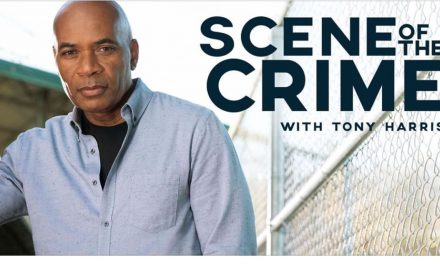atie Jurek was 19 years old when she was told the osteosarcoma, an aggressive form of bone cancer, had returned. She could amputate her leg or die within three months.1
For the teenager with a contagious smile, love of fashion and a determined streak from the state of Minnesota in America’s upper mid-west, it was an agonising choice.
“They told us immediately that it was terminal. When her type of cancer recurs … you simply can’t survive it,” Lynn Poferl recalled of her daughter, who was first diagnosed at 16. “She amputated and most people would think that’s an easy decision, but it really wasn’t.”
It was “the best thing she could have done”. Katie, who had been bed-ridden, regained her mobility. The surgery bought her two years to return to college and travel the world.

“We decided as a family we’re going to do whatever we can to create as many memories as possible,” Ms Poferl said.“She loved to travel so that’s what we did. She was going to live to live, not live to die.”
Her death, aged 20 in 2007, was devastating for former classmates from Tartan Senior High School in Oakdale. It was not the first time – and would not be the last – the grieving students had to bury one of their own.
Advertisement
Within seven years, another four teenagers died from cancer, all battling the disease while attending Tartan.
The fear that cancer is stalking their children has left some of Oakdale’s parents saddened and bewildered. “We’re bombarded with it,” said one mother, Kristi Schaut, who lost her daughter to leukaemia in 2007.
A Fairfax Media investigation in Minnesota has uncovered a further 16 cancer survivors who have attended Tartan Senior High School since 2002, all diagnosed during their primary, middle or high school years, or within 10 years of graduating.

It brings the tally to at least 21 cases in 15 years, and it’s a revelation with huge significance half a world away in Australia, starting with Williamtown, near Newcastle.
Residents of Williamtown’s Cabbage Tree Road also feel they have had more than their fair share of cancer. Last year, a Fairfax Media investigation exposed 50 cases in 15 years on a five-kilometre stretch of hobby farms and acreages.
And the situations bear another striking similarity: the two communities, on either side of the world, have both been heavily polluted with toxic per- and poly-fluoroalkyl [PFAS] chemicals, historically manufactured by chemical giant 3M.
Advertisement
Now Fairfax Media can reveal that at least 90 sites across Australia, including 25 in NSW with 10 in Sydney, 16 in Victoria and 15 in Queensland, are under investigation for elevated levels of the contaminants, linked to a slew of health effects including suppression of the immune system, reproductive effects, interference with hormones and some forms of cancer. The sites stretch from Bundaberg to Wangaratta, from Karratha to Botany Bay.
The Australian government is aggressively defending a growing number of class actions from towns where the chemicals were used for decades in fire retardants on military bases, the runoff tainting the soil and water of surrounding homes.
The Department of Health maintains there is “no consistent evidence” the chemicals can cause “important” health effects like cancer. In arguing this, its experts have made reference to the work of 3M scientists, who insist the chemicals are not harmful at the levels found in the blood of humans.
“The vast body of scientific evidence, which consists of decades of research conducted by independent third parties and 3M, does not show that these chemistries negatively impact human health at the current exposure levels,” a 3M spokesperson told Fairfax Media.
But now a lawsuit in Minnesota has brought to light extraordinary allegations of a decades-long cover up by 3M, accused of hatching a campaign to “suppress” the health risks of the products from the public.
The legal discovery process lifted the lid on thousands of internal 3M documents for the first time, allowing Minnesota authorities to chronicle how the company attempted to distort the science on the chemicals and manufacture doubt about their health effects.
The most startling of the allegations were levelled against a world-leading US academic, alleged to have accepted millions in secret payments from the company to help prosecute the case that the toxins were harmless.
Advertisement
“3M engaged in a widespread campaign to conceal the risks posed by PFAS from the public – a campaign that continues to this day,” the statement of claim read.
The town that 3M built
The Minnesota Mining and Manufacturing Company (3M) has come a long way in its 116-year history – now a global behemoth valued at $US122 billion ($163 billion), and behind global consumer brands like Scotchguard, Post-it Notes and Scotch Tape. The company employs more than 90,000 workers across more than 65 countries.

In the 1940s, its chemists stumbled on two chemicals that were unlike anything scientists had seen before. Formed by bonding fluorine with carbon, they were “stronger than some rocks”, one scientist noted. They repelled grease, oil and water, could migrate long distances and did not break down in the environment.
The pair would become the best known in broader family of chemicals called PFAS. Perfluorooctane sulfonate (PFOS) became the key ingredient in Scotchguard and perfluorooctanoic acid (PFOA) was sold to Dupont for the manufacture of Teflon cookware. The trade was lucrative, yielding more than $US480 million ($643 million) annually, before the company voluntarily exited the business in 2000.
Today, PFOS is the key concern in Oakdale and across dozens of sites in Australia, where it was used for decades in firefighting foams on military bases, industrial sites and fire stations.
Advertisement
“We’ve never seen anything like it before and we hope we never see anything like it again,” said James Kelly, manager of environmental surveillance and assessment at Minnesota’s Department of Health.
“They get into the environment and they get into the water and they don’t come out … it will accumulate [in the body] over time and it’s passed on to the fetus or through breast milk.”
By the 1960s, 3M settled on Maplewood in Minnesota for its global headquarters, about eight kilometres east of the capital St Paul. Today the sprawling 475-acre campus is home to a workforce of over 10,000 employees.
As 3M boomed, so did nearby Oakdale. New residential developments sprung up to accommodate the company’s burgeoning workforce and, by the early 1970s, the need for a new high school became apparent.
The school board settled on the named Tartan Senior High School, to the ire of some locals who objected to naming the school after a 3M product, Tartan Turf. The school, which now has 1700 students, has branded that a myth.
“The school was not named after any 3M products. The name was selected because of the tartan plaid design. The “plaid” represented the bonding of the multiple communities served,” a spokesperson said.
Advertisement
But the school’s yearbooks tell a different story, with at least two editions stating the school was named after the 3M product. Today the notion is widely accepted by locals.
“3M helped pay for our high school and we are named after some of their products,” teacher Jan Churchill says matter-of-factly. 3M named a nearby recreational area it owned ‘Tartan Park’. Nearly every person you speak to repeats the mantra: “3M is a big deal in this town”.
With about 28,000 residents, Oakdale is leafy and suburban. Weatherboard homes sit on large blocks, immaculately kept. But by the turn of the century, a chain of events would unfold leaving some residents questioning whether Oakdale had paid too high a price for the prosperity its largest employer had delivered.
In May 2000, 3M announced it would pull the pin on production of PFOS and work towards the phase-out of PFOA.
Within a few years, the company called a series of meetings with Minnesota government regulators, including the Department of Health and the Pollution Control Agency.
The bureaucrats were told that PFAS waste had been disposed of in the city’s landfill, along with dump sites at Woodbury, Lake Elmo and Oakdale.
“At that time none of us had even heard of these chemicals,” James Kelly, of the Department of Health, said. “We had to figure out: ‘okay what are these things and what does it mean?’”
The situation would get worse. By 2004, newly available laboratory tests showed the chemicals were in Oakdale’s public drinking water supply. Average PFOS concentrations in all but one of the wells were above safe levels, and had probably been for many years. The maximum concentration was more than 20 times what is today deemed the safe level in the United States.
A filtration plant, paid for by 3M, came online in 2006 and is still operational, removing the chemicals from the two most contaminated wells.
In five decades, man-made PFAS chemicals became ubiquitous across the globe: entering the blood of more than 95 per cent of the population, polar bears in the Arctic and baby eagles that had never left the nest.
But Oakdale, in Minnesota, had become ground zero for the global crisis.
‘A life interrupted’
After Melissa Crowley’s 17-year-old son Alex died in 2012, she found herself unable to cook any of the foods that he loved.
So this year, on the sixth anniversary of his death, Melissa and her husband Jim decided to buy all of Alex’s favourite foods and eat them in one day: fish sticks, french fries, hot dog on a stick, pizza, mash potatoes.
“We were in a food coma,” Ms Crowley laughed.
“We had some leftovers – there was a limit to what we could accomplish – but we had to eat some of everything,” Mr Crowley said.

06:12
‘You feel guilt. You couldn’t protect your child’
Playing in 5 …
The Crowleys and Schauts are just two of many families whose lives have been affected by the high rate of childhood cancer in Oakdale Minnesota.
Alex was seven when he was diagnosed with “garden variety” medulloblastoma, a brain tumour.
“[The doctors] said if you’re going to get a pediatric brain tumour, this is the one you want,” Mr Crowley recalled. “It was somewhere between 85 and 95 per cent cure rate”.
The Crowleys “tried to be good parents”, diligently following every instruction from the doctors. When Alex began having fine motor issues, they bought him a PlayStation to take to hospital.
“Alex would walk into the hospital wheeling this cart and luggage and everyone would say ‘here come the Crowleys again, because they bring their own entertainment system to the hospital’,” Ms Crowley said. “It was something”.
But the cancer recurred – four times. Alex was small and struggled with the heavy bouts of chemotherapy. Eventually an infection took hold is his bowel and his heart stopped. Alex had life after school mapped out: he would become an accountant, buy a Jaguar and a cabin on the lake, with a pontoon party barge for his mum. The order of service at his funeral was titled: “Alex’s Hopes and Dreams … Interrupted”.
Mr Crowley still has days where he “melts down” and can’t function. But they’re fewer in between now.
“For a long time … whenever you think about him, it would just be ‘he’s dead’. Now I have happy thoughts,” Mr Crowley said. But he worries about the toll their journey has had on his daughter, Amanda, now in her 20s.
When asked about the water contamination and rates of cancer at Tartan High School, Mr Crowley admits it is something that has crossed his mind.
“I mean there is no proof, but it certainly looks suspicious, let’s put it that way,” he said.
‘This is how they fight’
It’s a balmy Friday evening in late May as hundreds of students, teachers, family and friends mill around the track at Tartan Senior High School, on the day of the annual Relay for Life event.
The inaugural cancer fundraiser was held in 2002, as the students rallied behind Katie Jurek in her battle with bone cancer. As the number of cancer diagnoses at the school spiralled, the event gained momentum. 2012 was a milestone year: the school hit a fundraising total of $US1 million in a decade, making it one of the top performing schools in the US. It was also the year Alex Crowley became its fifth student to pass away from cancer in seven years.

“This event came out of the heart and soul of Tartan,” said Ms Churchill who has organised the event since its inception. “It’s how they respond to losing their friends to cancer. This is how they fight.”
Ms Churchill, who is nearing retirement, works on planning for the relay nearly year-round, along with her team of students. Throughout the night a steady stream of teenagers approach her: asking her for advice, offering her coffee. She beams as she speaks about their contribution.
“I give them ideas, but I have really strong kids,” she said. “They believe in what they can do.”
To Ms Churchill, whose husband is a cancer survivor, the cancer toll at Tartan is too high for a school of its size.
“We just have a lot of kids who are sick and parents who are sick,” she said.
“Five children have lost their battle, they’re not just fighting, they’ve died. That doesn’t even start with the number of kids who are sick.”
She is circumspect when asked about a potential connection to the water contamination.
“I don’t like to drink the water in the school. I bring water in from home,” she said.
“I have four grandchildren and I want them to grow up safe. I want them to grow up with business people who care and pay attention.”
At this year’s Relay are six current and former Tartan students diagnosed with cancer before the age of 18: Katelyn O’Connell, Derek Lowen, Petra Jacobsen, Eli Knight, Ben Rule and Amara Strande.
Ms O’Connell, 25, was in fifth grade when she started getting nose bleeds in the middle of the night.
“I would wake up and my face, shirt, pillow were covered in blood,” she said. “My teacher said something was wrong because my smile wasn’t reaching my eyes.”
The doctor rang her mother in the middle of the night; the next day she was diagnosed with leukaemia.

“I just wrote a note to my brother saying ‘I’m not the best sister but if I die, I want you to know that I love you’. I was only 12,” she recalled.
Ms O’Connell was a talented athlete, with dreams of playing basketball professionally after high school. But the treatment – including three years of chemotherapy – was debilitating. Ms O’Connell had her first knee replacement by the age of 16 and spent two years in a wheelchair. She still struggles with “constant pain” and one of her arms will not fully straighten.
“There are still times I wonder: ‘why didn’t this happen to someone else?’” she admits.
“My dreams and goals went out the window. My love of sports went out the window. I wonder constantly what my life would be like now: ‘would I be successful? Happily married?’”
Ms O’Connell became close with another Tartan student, Nikki Schaut, who was battling abdominal cancer and chemotherapy-induced leukaemia. Nikki lost her fight the day after Thanksgiving in 2007, at the age of 16.
“It was the worst phone call of my life,” Ms O’Connell recalled. “Like telling you your sister died.”
While Ms O’Connell was undergoing treatment, a “baseball-sized” tumour was found in the brain of her brother’s best friend, Derek Lowen. He was 14 years old and the timing struck his mother, Lori Olmstead, as strange.
“You’ve got two kids who grew up four blocks away from each other and they’ve both got cancer at the same time,” she said. “I think Tartan has had an awful lot of cancer.”

While Derek recovered and is now in college, he suffers from permanent short-term memory loss, and his balance and fine motor skills have been affected. Ms Olmstead said the experience had been “traumatising” for the family.
“I have a 28-year-old son who has lasting disabilities as a result of his tumour,” she said. “3M, I think they should have to reimburse people.”
Tartan’s relay has become a “big part” of the lives of the Schaut family, with Kristi Schaut invited as guest speaker one year to honour the memory of her daughter, Nikki.
“I don’t think there’s been a year [the relay has been held] that there hasn’t been somebody in the school that’s had cancer,” Ms Schaut said. The family can count seven close neighbours who have battled the disease, four of them passing away.
Nikki was born with a heart condition, and developed an aggressive abdominal cancer called desmoplastic small round cell tumour (DSRCT) when she was in fifth grade. The cancer is so rare that, worldwide, fewer than 200 cases have ever been reported.
“When she was first diagnosed she lost like half her body weight,” Ms Schaut recalled. “So Mark [her father] had to carry her up and down the stairs, we had to carry her into treatment.”

Nikki was guarded and shy. But her family remembers her as a deep thinker, and someone who cared deeply about others.
“She felt that she had a purpose and her having the cancer had a purpose. And she told us that one day she figured she would talk to God and find out what her purpose was,” Ms Schaut recalled.
Nikki’s younger sister, Emile, was too young at the time to understand why they couldn’t do “normal family stuff”.
“It’s weird to think that I’ve spent kind of half my life without her,” Emile, now 22, said.
Navigating the numbers game
Around the mid 2000s, several parents made inquiries with the Minnesota Department of Health over a possible cancer cluster at the high school. Bill Fowler, whose son Aaron died of leukaemia aged 17, was one of them.

“I made the call because we were curious about the number of cancer cases at Tartan. Even though all of the cancers were different types, we were still interested in if the Department of Health was concerned,” he said.
“I was just told that the numbers did not qualify for a cluster … I don’t believe they were uncaring or not concerned, the numbers just did not meet their criteria.”
But over a decade later, fresh eyes looked over the data, and the findings were disturbing. As part of a lawsuit launched by Minnesota Attorney-General Lori Swanson against 3M, cancer statistics were crunched for Washington County, to which Oakdale belongs, where several drinking water supplies had been contaminated.
The analysis was carried out by Professor David Sunding from the University of California Berkeley, who has served on the US EPA’s scientific advisory board and as an adviser to president Bill Clinton.
Professor Sunding found children who died in Oakdale were 171 per cent more likely to have had a diagnosis of cancer than children who died in unaffected areas.
Mothers in Oakdale were 34 per cent more likely to have a child born with low birth weight and were less fertile than in unaffected parts of the same county, a trend that slowed when Oakdale was connected to clean water in 2006.
Washington County had statistically significant higher rates of prostate, breast, bladder and kidney cancer than the rest of Minnesota, along with elevated rates of leukaemia and non-Hodgkins lymphoma.
The findings resonated on the other side of the world, where residents of Cabbage Tree Road in Williamtown were exposed to high levels of PFOS and developed the same types of cancer in large numbers.
But a week before the court case was due to go to trial, the Attorney-General’s office was hit with a curve ball – seemingly pitched by its own team. The Minnesota Department of Health released its own analysis, which it said did not show any unusual rates of cancer or adverse birth outcomes in the contaminated areas.
In a further twist, an internal Minnesota Department of Health email was leaked to the local media, in which an employee described its own study as “rushed”.
“The cancer portion will be weak; much below our historical standards,” the email reportedly said. “We are working furiously to make the report as palatable as we can, but it will be nowhere near our standards and frankly it will run the political risk of embarrassing MDH.”
There was a withering response from the Attorney-General , Ms Swanson, who described the leaked email as “deeply troubling”.
RELATED GALLERY

“I can only conclude from this that the agency is embarrassed because it is so late to the table in protecting public health,” she said.
A closer look at the Minnesota Department of Health report raises questions as to whether Oakdale was really given a clean bill of health. The report identifies a 56 per cent “excess” of cancers among Oakdale children up to the age of 19 compared to the statewide rate between 1999 and 2014.
The number of deaths from cancer in the same age group was higher than expected during a similar time period.
Looking at the adult population, the analysis found a 12 per cent elevation in female breast cancer in Oakdale and an 8 per cent elevation in total cancers.
The Department played down the findings, saying sometimes there was not “a really apparent explanation” for fluctuations.
“That’s important to keep in mind when you start to talk about small numbers of cases you can get big percentages like that,” Mr Kelly said. “That can be a little bit misleading in terms of what it’s actually pointing to.”
University of Minnesota epidemiologist Dr Logan Spector said between 5 and 10 per cent of childhood cancers were due to “bad news genes”, while demographic and birth variables could be related. He argued there were not any “smoking guns” when it came to childhood cancer and exposures in the environment.
But Professor Joel Tickner, a public health expert from the University of Massachusetts Lowell, countered that there was “very good evidence” linking certain environmental exposures and childhood cancer.
“What you should know is that teenage cancers are one of the few that are going up in incidence and we do suspect environmental factors to be a potential cause,” he said.

01:41
‘I’m definitely not the same anymore’
Playing in 5 …
About two years after attending Tartan High School, John Leibel was struck down by Hodgkin’s lymphoma at the age of 20.
‘Money to fix the problem’
When a $US850 million ($1.14 billion) settlement was reached in the lawsuit between the State of Minnesota and 3M earlier this year, it was touted as a victory by both sides.
“This money is dedicated to fixing the problem,” Ms Swanson told reporters. “This was hard-fought litigation.”
The lawsuit was over damage to natural resources in the state, including the pollution of aquifers providing drinking water for around 125,000 people in Minnesota.
3M did not accept any liability for the contamination and titled the settlement money, which will go towards clean water projects, as the “3M Grant for Water Quality and Sustainability Fund”.
“We are proud of our record of environmental stewardship, and while we do not believe there is a [PFAS] related public health issue, 3M will work with the State on these important projects,” said John Banovetz, 3M senior vice president for Research and Development.
But the victory has rung hollow for some Oakdale residents who believe they have developed cancer as a result of the contamination. John Leibel attended Tartan High School and was struck down by Hodgkin’s lymphoma at the age of 20.
“My oncologist actually said, ‘Yes, this is straight up environmentally caused,’” said Mr Leibel, who has recovered and is now in his 30s.
Mr Leibel is one of several locals who speak of rumours that when the school’s track was resurfaced in the mid-2000s, barrels of waste were discovered buried in the ground. The school has rejected the rumours.
Mr Leibel said he was surprised when talking about cancer to people who grew up in unaffected areas.
“It’s like, ‘oh you mean that’s not common for you? Cause this is a regular thing around here, you flip a coin, maybe you’ll get cancer or you won’t. But you probably will if you stick around here long enough,” he said.
“I’ve accepted the fact that there’s not going to be any justice over this,” he said.
But the Commissioner of the Minnesota Pollution Control Agency, John Stine, described the settlement as a “huge” win in securing clean drinking water for the people of Minnesota.
To him, the contamination is personal. He raised his family in Oakdale, and worries about potential health problems for his two children in the future. Two of his neighbours worked for 3M and didn’t know how to react to the revelations the water was toxic.

02:50
‘No one told me I was being exposed’
Playing in 5 …
Commissioner of the Minnesota Pollution Control Agency, John Linc Stine, says there is a sense of violation in the community after 3M disposed of chemicals that have now seeped into the groundwater.
“Do I believe the company that I work for, who tells me there’s nothing to be concerned about? Do I believe these other people who say this is going to cause health effects?” he said.
“I remember standing in front of a room full of hundreds of people, all wanting answers obviously. Some defending their employer. Some defending the state. Some asking the hardest questions I’ve ever faced in my life.”
Mr Stine stressed that 3M was generally a responsible company that did not want to “pollute their own well”. But his voice cracks as he speaks about revelations within the lawsuit that 3M was not “duly forthcoming” with the truth, as the community unwittingly drank and used tainted water for decades.
“That’s the sense of violation people feel. Once it’s happened, it’s too late. It’s like your relationships. Do you like it when people tell you that I lied about this or I lied about that and then you found out about it later?” he said.
“That’s why it’s more than professional to me. It’s personal. It’s my family. And it’s a risk I can’t do anything about.”
‘Medically famous’
Amara Strande 16, has delivered a heartfelt speech at Tartan’s relay, detailing her last 12 months.

She became “medically famous” after a volleyball-sized tumour was found on her liver; a type of cancer rarely seen in children but common in alcoholics and people with hepatitis.
Amara has recovered with treatment but is unsure of what the future holds.
“The only thing I will regret from high school is if I leave only being known as the girl who has cancer. I want to be remembered for who I am, not the events that happened to me.”












